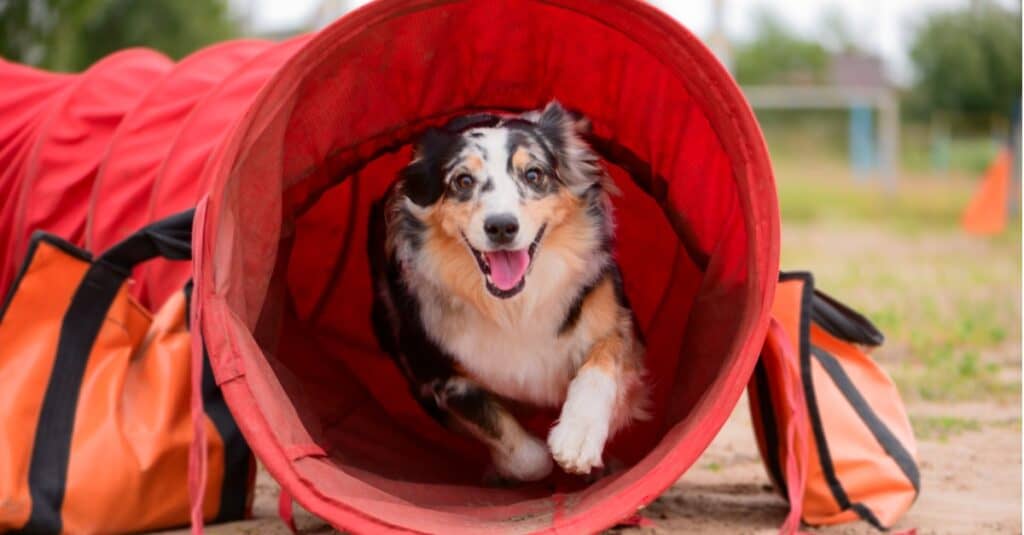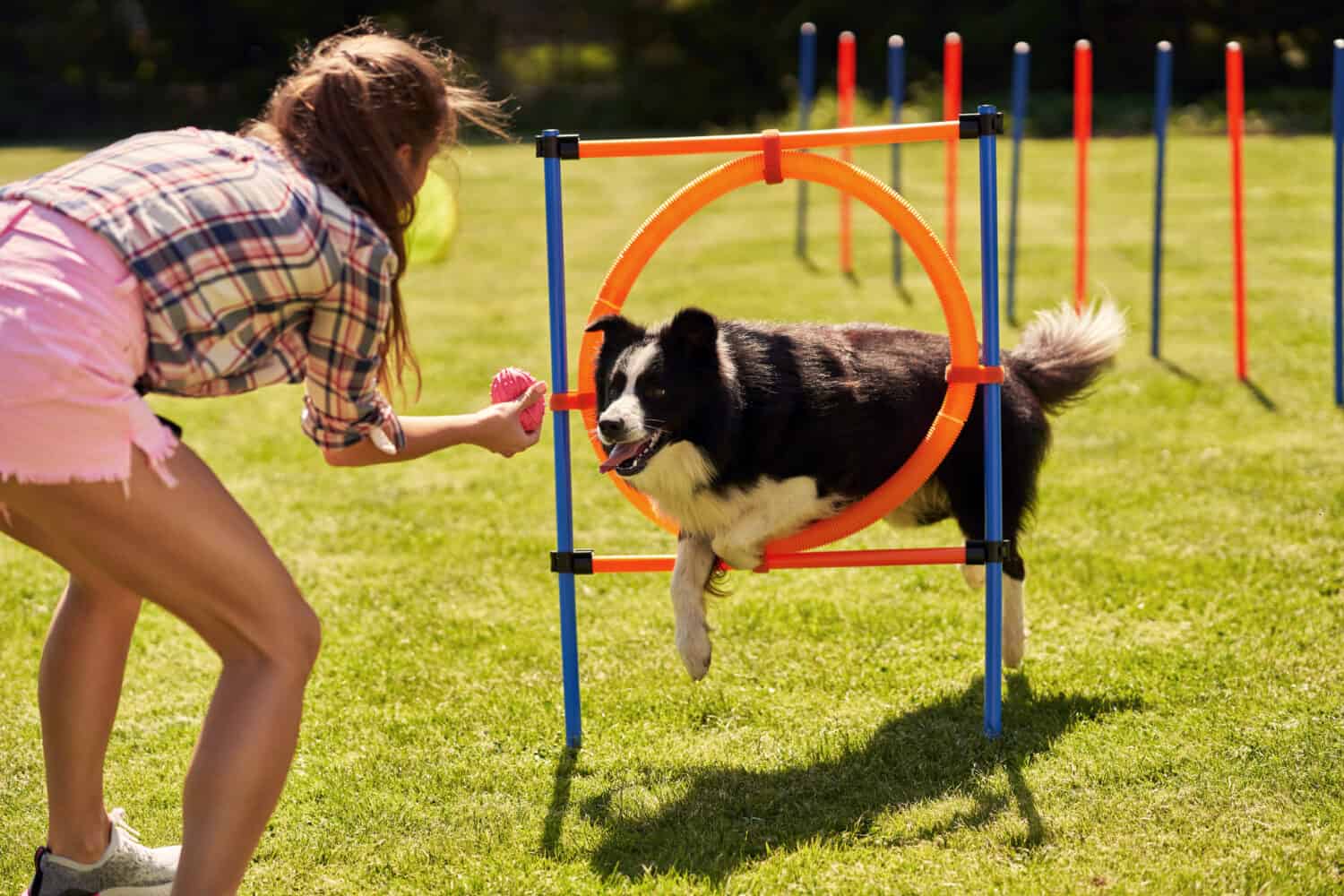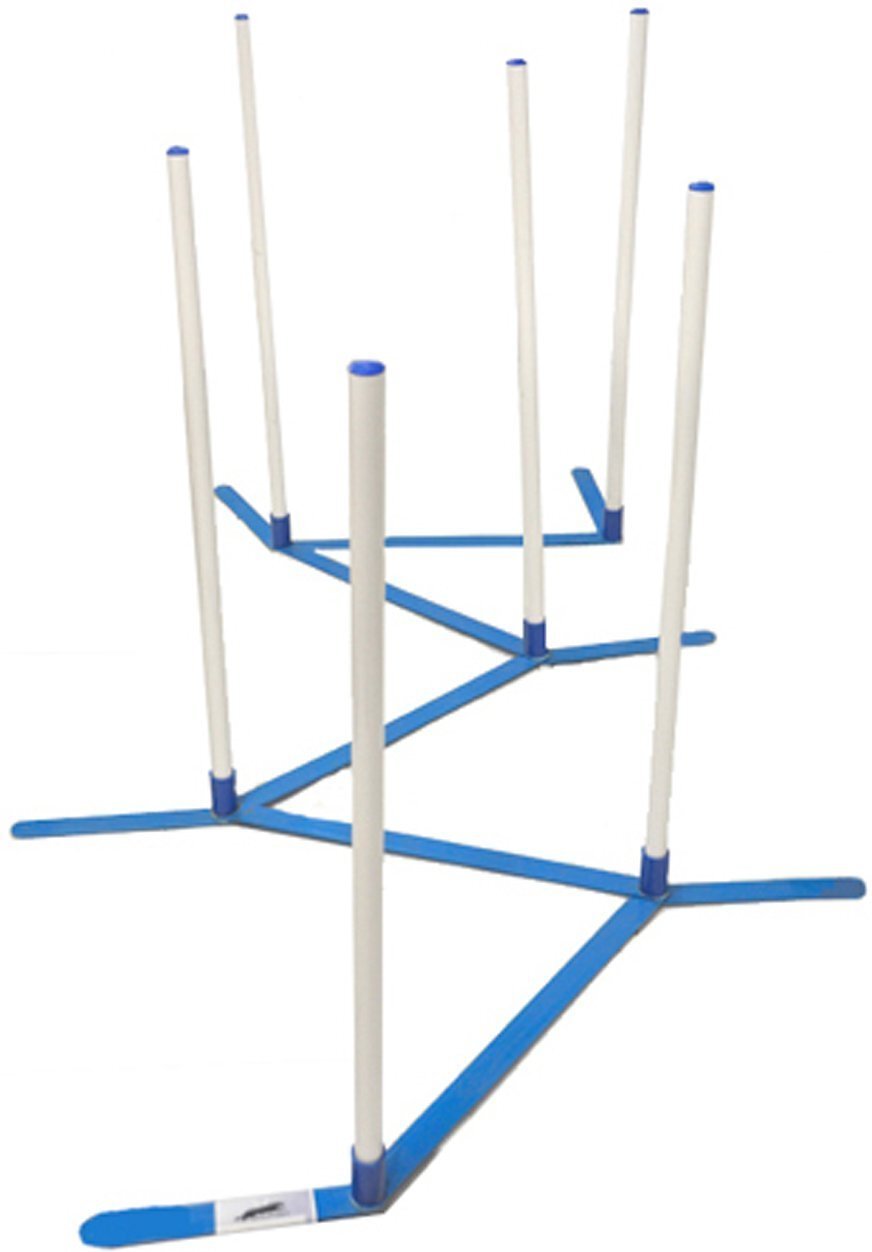Why You Need Dog Agility Equipment at Home
In general, you can put in some dog agility practice at home if you have a few key pieces of dog agility equipment.
Most handling skills and obstacles need many practice iterations before they are cemented in your mind and that of your dog. Lessons do not usually allow for that much time, because there are other dog handler teams in the class – they need their time too! Additionally, it is usually better to spread that time over the span of a few days or weeks.
Aside from being able to practice key techniques, having a few items at home makes playtime with your pup more fun. You can make them use their brains! Use that tennis ball as a reward instead of the sole activity. Tiring a dog out physically is challenging, but when you combine physical activity with mental work, you get a tired and satisfied dog that is much less likely to get into trouble.
Decide on Your Dog Agility Equipment Budget
Before you go out looking at equipment and choke on the prices, set a budget. How much can you spend on dog agility equipment for home practice? Some obstacles are expensive, can you set aside a set amount per month? If so, try setting aside $100 per month. If you can get a single piece of dog agility equipment like a tunnel or a few jumps with that, great! If you need something bigger, save up for a couple of months.
Depending on which obstacle, the cost varies widely. For example, a decent portable tunnel is about $160 with sandbags – however, $30 kids’ play tunnels can also work temporarily or for longer with small dogs. Jumps cost $30 and up, and contact obstacles are the most expensive items — most people do not purchase them.
How to Balance Budget with Function in Dog Agility Equipment
Although you may want to go out and buy or build everything, be selective! Choose dog agility obstacles that give you the most bang for your buck.
Oftentimes, people focus on the big stuff: dog walks, A-frames, and teeters. Yet, those are frequently too expensive to justify, especially in the beginning. On the other hand, jumps and hoops are the cheapest obstacles to build yourself. They have the added benefit of being useful for nearly every handling technique you will ever need in dog agility.

Dog agility tunnels don’t need to be competition-worthy, just enough to help your dog learn the obstacle.
©iStock.com/Irina Orlova
Cost Breakdown
Here’s a handy chart with the approximate costs of different dog agility equipment you can use at home that won’t break a budget — none of these items are competition-quality but are perfect for practice!
One word of caution: If you are making them yourself, take the time to study the equipment regulations for the agility organizations that you plan on playing in.
- North American Dog Agility Council (NADAC)
- American Kennel Club (AKC)
- United States Dog Agility Association (USDAA)
- UK Agility International (UKI)
- Australian Shepherd Club of America (ASCA)
| Purchase Cost | DIY Cost | |
|---|---|---|
| Jumps | $10-$49 each | $10-$15 each |
| Barrels | $5-$45 Can be a laundry hamper! | Seriously, just buy a cheap laundry hamper or use a resident tree. |
| Tire Jump | $15-$40 | $25 |
| Contact Trainer | $89 | Free if you can find a 12″ wide 4-6 foot-board |
| Weave Poles | $46-$150 for six | $45-$150 for six |
Space Considerations
While cost is an important component of getting dog agility equipment on a budget, it isn’t the only consideration. If you live in an apartment or condo without a yard, you must travel to the park for practice. You can practice some things inside, but if you need to do any distance work, it won’t be at home.
Any agility equipment you buy, or build must suit your lifestyle and available space. If you have a big yard and can set up a full course, then go for it! However, if you live in a small space, bigger equipment like dog walks and A-frames may be out of the question.
Try to Find Used Items
As much as we all love dog agility, we eventually get too old to run around on a course. Sometimes a former competitor retires and sells off their equipment – in cases like this, you can often get great equipment at a fraction of the normal cost.
Sometimes, we upgrade because we want something nicer and can now afford it – so we sell off the equipment that we are replacing. You may also find used equipment through local dog agility clubs. Members often network with each other to buy and sell equipment.
In the end, it does not matter why they are selling their equipment, because you may be able to benefit. Online marketplaces like Facebook and Craigslist are also fantastic resources.
DIY Dog Agility Equipment
If you love to DIY your stuff, dog agility equipment is a great place to stay within your budget. You probably won’t be able to build a tunnel. However, for most practice equipment, all you need is a few 10-foot-long sticks of 3/4-inch PVC, fittings, and bolts. Competition jump standards (the upright support) are often one-inch PVC, but yours do not need to be that heavy – lighter weight PVC makes taking your set up to a park or other open area easier.
The easiest and cheapest dog agility equipment you can build or repurpose on a budget are:
- Jumps
- Hoops
- Tire jump
- Weave poles
- Barrels
- Pause table/platform — not all dog agility organizations use it anymore, but it is a good training tool anyhow.
Of course, the hardest obstacles to make yourself are the big things like the contact obstacles: dog walks, teeters, and a-frames. If you are handy with a saw and feel comfortable building things, contact obstacles can absolutely be DIY projects!

Practice dog agility equipment doesn’t have to be fancy or break your budget.
©Kamil Macniak/Shutterstock.com
When Renting Dog Agility Facility Time is Better
If you cannot have equipment at home, it isn’t the end of the world. Many facilities allow you to rent the space and use the equipment for a fee.
The fees can get expensive, not to mention any travel time. However, renting facility time is sometimes more effective. For example, most of my dog’s weave pole practice is at home, in our tiny backyard. There isn’t enough space to run, so she only sees me sending her to the weave poles. At a trial, I run! The course is 15 or so obstacles long and she is fast. However, that difference between running and not running changes how I need to guide her through the course. So, renting time at our trainer’s facility is a better use of my time than packing up all my practice stuff and taking it on the road somewhere.
Renting the space not only gives me access to the space but also all of the contact obstacles, which I definitely do not have room for in our yard!
Use the World Around You
If you think about it, anything can become a dog agility obstacle: trees and laundry hampers become barrels, downed tree limbs become jumps, park benches become pause tables — you get the idea. Use your imagination and you never know what you’ll find.
No matter how much you spend or where you get your agility equipment, remember to have fun. This game isn’t about who has the best “stuff,” or spends the most money, it is about the relationship you have with your dog!
The photo featured at the top of this post is © Mark Herreid/Shutterstock.com
Ready to discover the top 10 cutest dog breeds in the entire world?
How about the fastest dogs, the largest dogs and those that are -- quite frankly -- just the kindest dogs on the planet? Each day, AZ Animals sends out lists just like this to our thousands of email subscribers. And the best part? It's FREE. Join today by entering your email below.
Thank you for reading! Have some feedback for us? Contact the AZ Animals editorial team.








